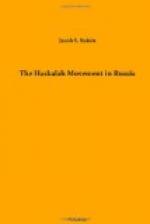The striving for intellectual enlightenment manifested itself in the refining of religious customs. Though Russian Jewry “has never experienced any of the ritualistic struggles that Germany has witnessed,"[14] yet reform and Haskalah always went hand in hand. The attacks on tradition by the Maskilim of the “forties” and the early “fifties” were mild and guarded compared with the assaults by the generation that followed. With the appearance of the periodicals the combat was intensified. Ha-Meliz, and, later, Ha-Shahar in Hebrew, and Kol Mebasser in Yiddish were the organs of those who were dissatisfied with the old, and sought to introduce the new. It was in the latter that Dos Polische Yingel (The Polish Boy), by Linetzky, first appeared, and it proved so popular that the editor published it in book form long before it was finished in the periodical. In an article on The Ways of the Talmud, by Moses Loeb Lilienblum, the prevailing Jewish religious observances were vehemently attacked. This was followed by another article from the pen of Gordon, Wisdom for Those Who Wander in Spirit, with suggestions for adapting religion to the needs of the times, and a still more powerful one, The Chaotic World, by Smolenskin. The muse ceased to content herself with “flame-songs that burn their pathway” to the heart. She preferred to appeal to the head. She no longer tried
In strains as sweet
As angels use ... to whisper peace.
In cutting criticisms and biting satires she exposed time-honored but time-worn beliefs and practices. Gordon was a militant reformer in his younger days, and so were Menahem Mendel Dolitzky and the lesser poets of the period. Needless to say, the Jewish-Russian press was an enemy of ultra-orthodoxy. Osip Rabinovich, the leading Russo-Jewish journalist, made his debut with an article in which he denounced the superstitious customs of his people in unmeasured terms.[15] The motto chosen for the Razsvyet (1860) was “Let there be light,” and the platform it adopted was to elevate the masses by teaching them to lead the life of all nations, participate in their civilization and progress, and preserve, increase, and improve the national heritage of Israel.[16]
Yet journalists and poets were outdone by scholars and novelists in the battle for reform. Lebensohn’s didactic drama Emet we-Emunah (Truth and Faith, Vilna, 1867, 1870), in which he attempts to reconcile true religion with the teachings of science, was mild compared with Dos Polische Yingel or Shatzkes’ radical interpretations of the stories of the rabbis in his Ha-Mafteah (The Key, Warsaw, 1866-1869), and both were surpassed by Raphael Kohn’s clever little work Hut ha-Meshullash (The Triple Cord, Odessa, 1874), in which many prohibited things are ingeniously proved permissible according to the Talmud. But the most outspoken advocate of reform was Abraham Mapu (1808-1867), author




